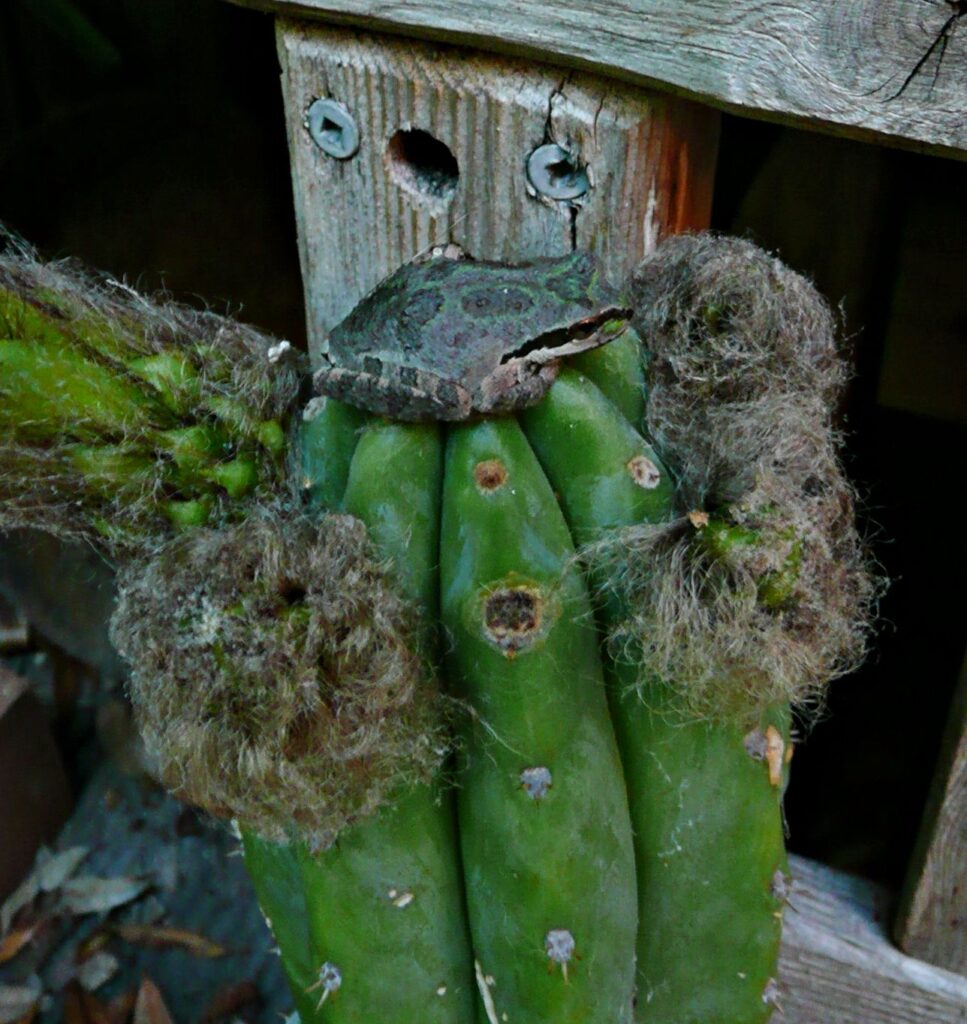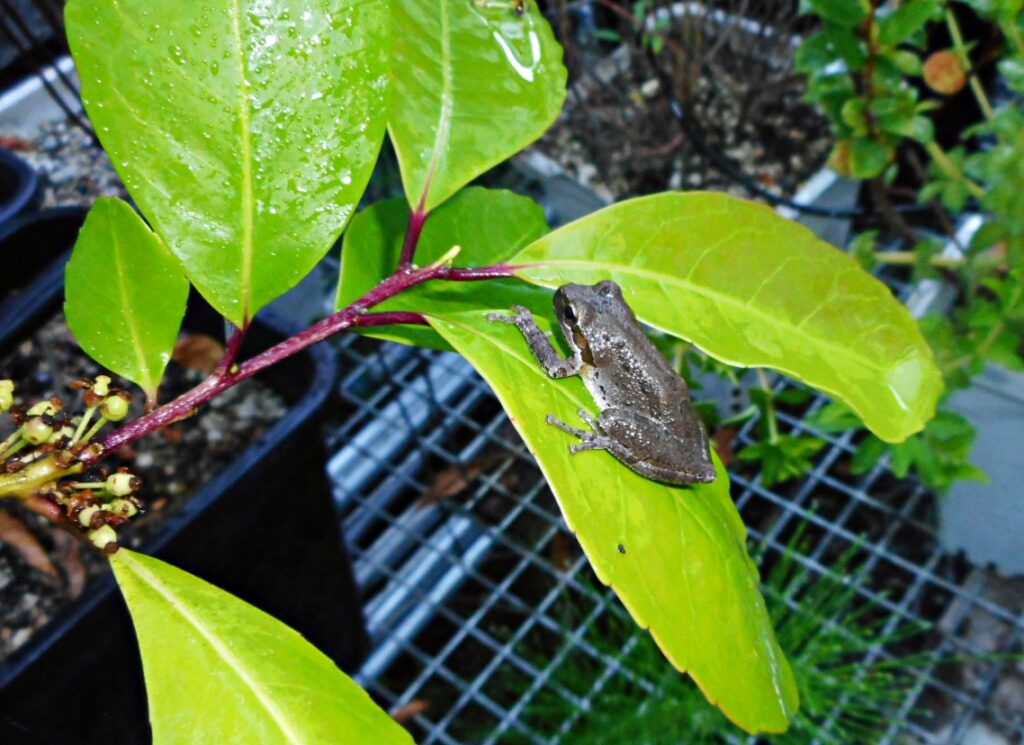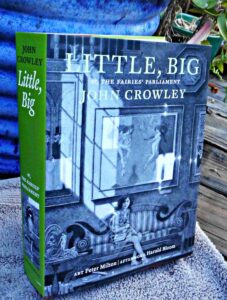To receive our periodic (usually every 4-8 weeks) emails listing new plants, sales & auction fundraisers, news from our gardens, greenhouses & travels, and occasional articles on various botanical topics, sign up at –
http://lists.sonic.net/mailman/listinfo/sacredsucculents
NEWS:
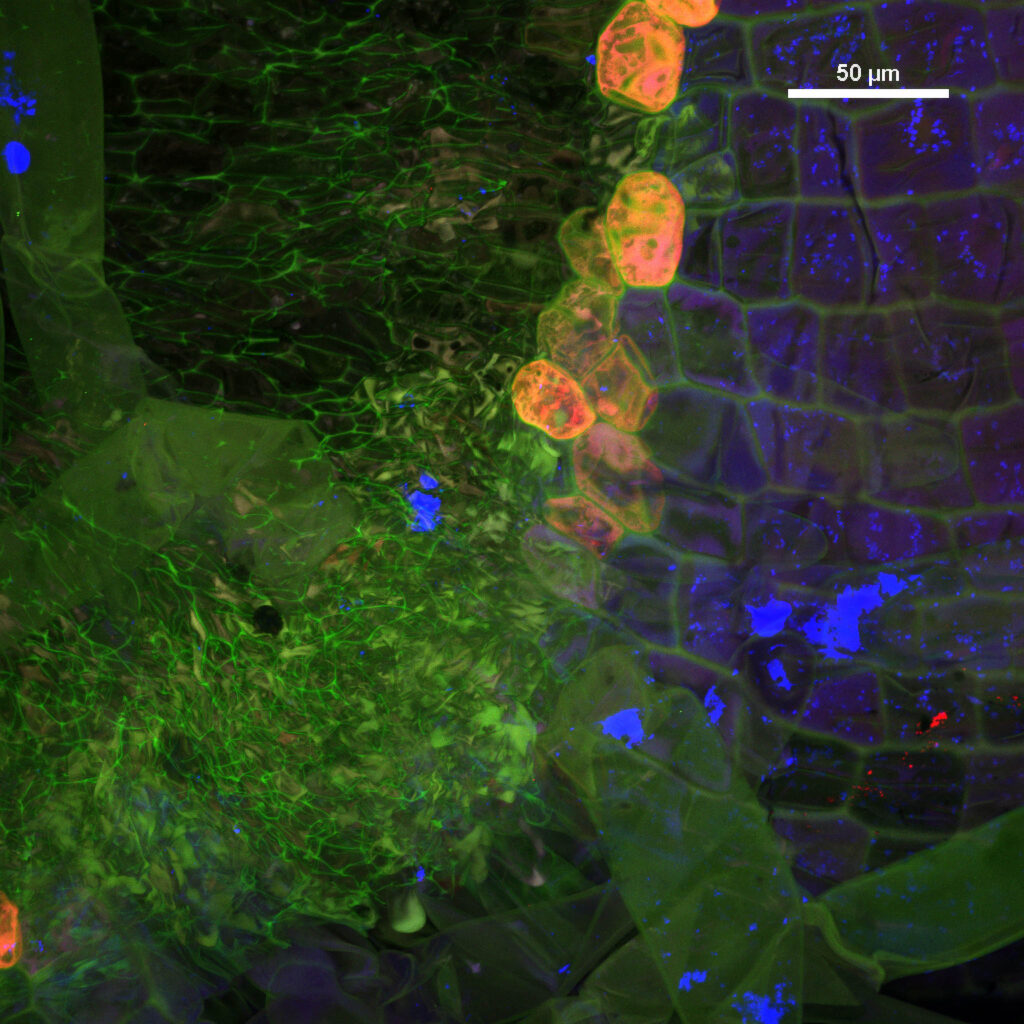 Trichocereus pachanoi scanned at St. Lawrence University’s Microscopy & Imagery Center, from Microcosms: A Homage to Sacred Plants of the Americas (https://www.microcosmssacredplants.org/), used with permission of Jill Pflugheber & Steven F. White, © 2023.
Trichocereus pachanoi scanned at St. Lawrence University’s Microscopy & Imagery Center, from Microcosms: A Homage to Sacred Plants of the Americas (https://www.microcosmssacredplants.org/), used with permission of Jill Pflugheber & Steven F. White, © 2023.
For several years I’ve been contributing plants to Steve White and Jill Pflugheber’s fascinating scientific art project, Microcosms — wondrous images of American sacred plants produced through confocal microscopy. The site was just updated — a few sections now feature my Andean photos, with more to come.
You can read my commentary on the project: https://www.microcosmssacredplants.org/commentary/ben-kamm/
I’ve also contributed an article on the Andean keystone tree Polylepis – https://www.microcosmssacredplants.org/plant/polylepis-spp/
Peruse the comments of other colleagues such as Neil Logan, Manolo Torres, Dennis McKenna, Luis Eduardo Luna, etc.: https://www.microcosmssacredplants.org/commentaries/
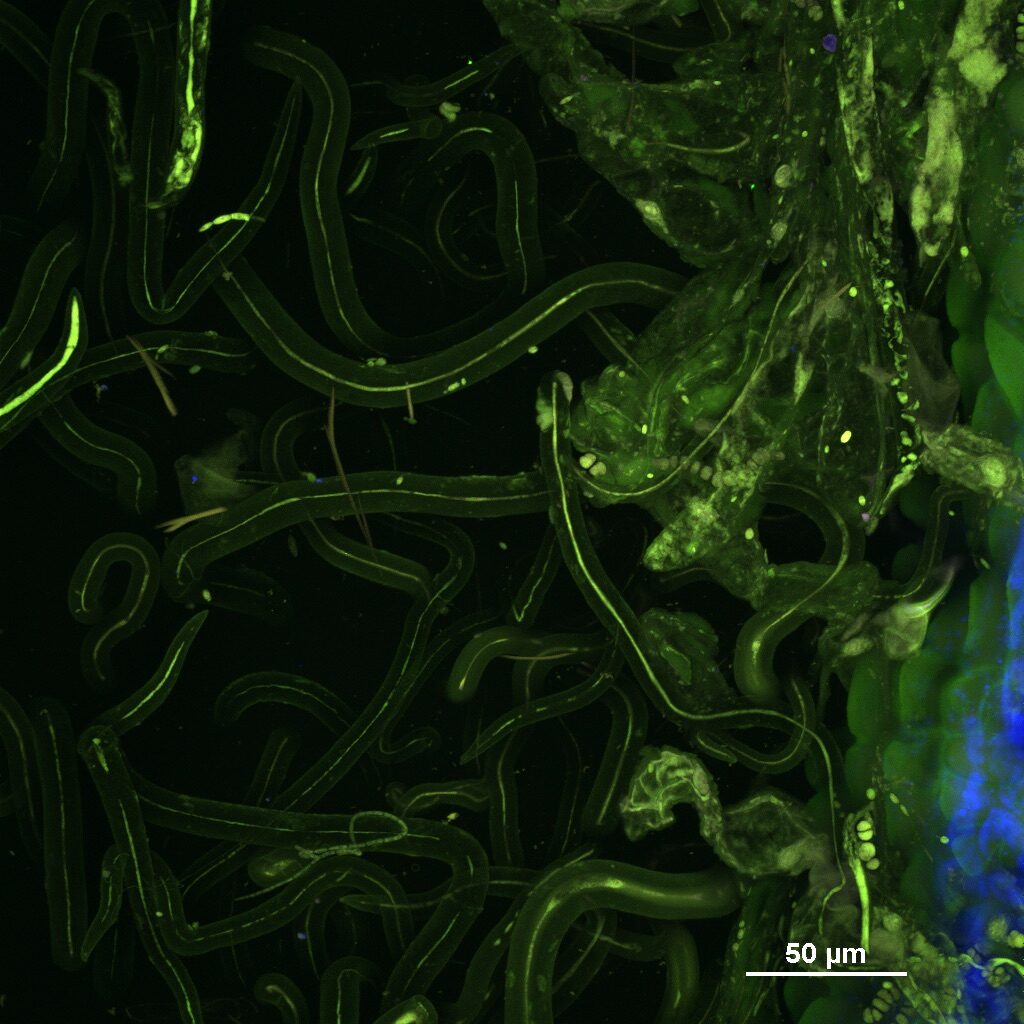 Polylepis incarum scanned at St. Lawrence University’s Microscopy & Imagery Center, from Microcosms: A Homage to Sacred Plants of the Americas (https://www.microcosmssacredplants.org/), used with the permission of Jill Pflugheber & Steven F. White, © 2023.
Polylepis incarum scanned at St. Lawrence University’s Microscopy & Imagery Center, from Microcosms: A Homage to Sacred Plants of the Americas (https://www.microcosmssacredplants.org/), used with the permission of Jill Pflugheber & Steven F. White, © 2023.
~~~~~~~~
Herpetological Kin:
In addition to the diversity of rare and endangered plants here, the nursery and gardens also provide habitat for a medley of ‘wildlife’. We rejoice that the herpetological denizens are really thriving in recent years—our native treefrog (Pseudoacris sierra) is the most abundant resident of the nursery along with blue-belly lizards (Sceloporus occidentalis); we also have the more solitary alligator lizards (Elgaria multicarinata) and the secretive blue-tailed skinks (Plestiodon skiltonianus)—all of the lizards have taken to breeding and overwintering in the big greenhouse. We see a medley of small snakes here: striped racers (Coluber spp.), ring-necked (Diadophis punctatus amabilis), gartersnakes (Thamnophis spp.), sharp-tailed (Contia spp.), the occasional gophersnake (Pituophis catenifer), and my daughters’ favorite—the shy and gentle rubber boa (Charina bottae). The nursery and environs also provide habitat for worm-like slender salamanders (Batrachoseps attenuatus), friendly faced Ensatinas (Ensatina eschscholtzii), rough-skinned newts (Taricha granulosa) with their affable demeanor, orange bellies and highly toxic skin, the occasional arboreal salamander (Aneides lugubris), and the intimidating giant Pacific salamander (Dicamptodon ensatus). A large Sequoia tree that toppled in our stretch of creek last year is now the preferred basking spot for our local Western ‘pond’ turtles (Actinemys marmorata)—we’ve observed up to 6 at a time sunning themselves, from 1.5″ juveniles to 9″ seniors!
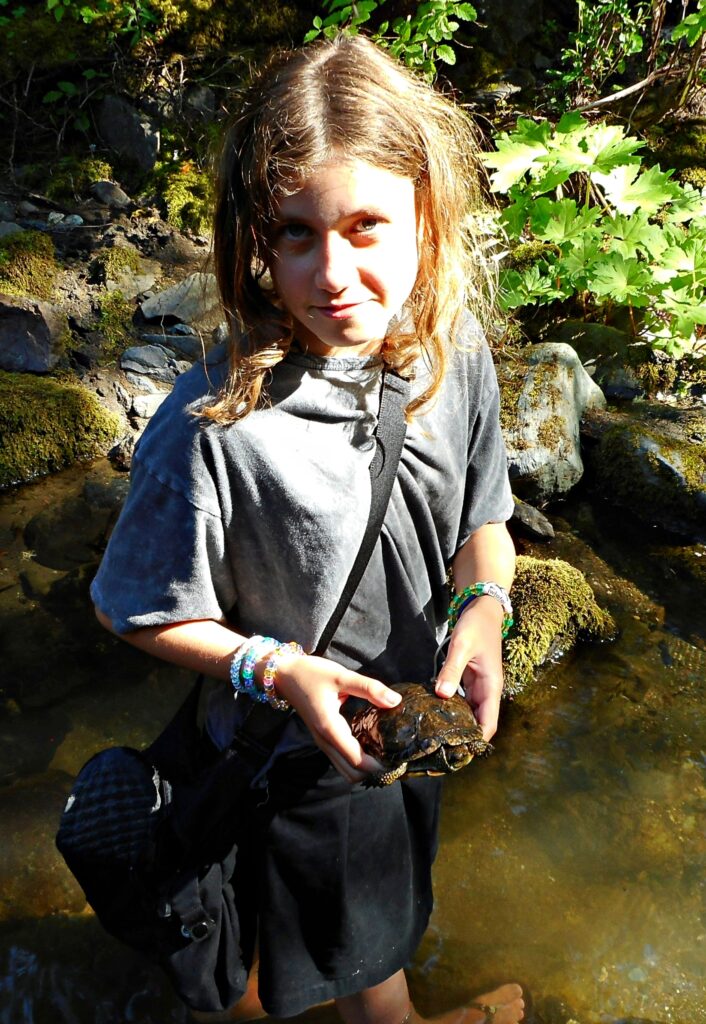 Ember with turtle
Ember with turtle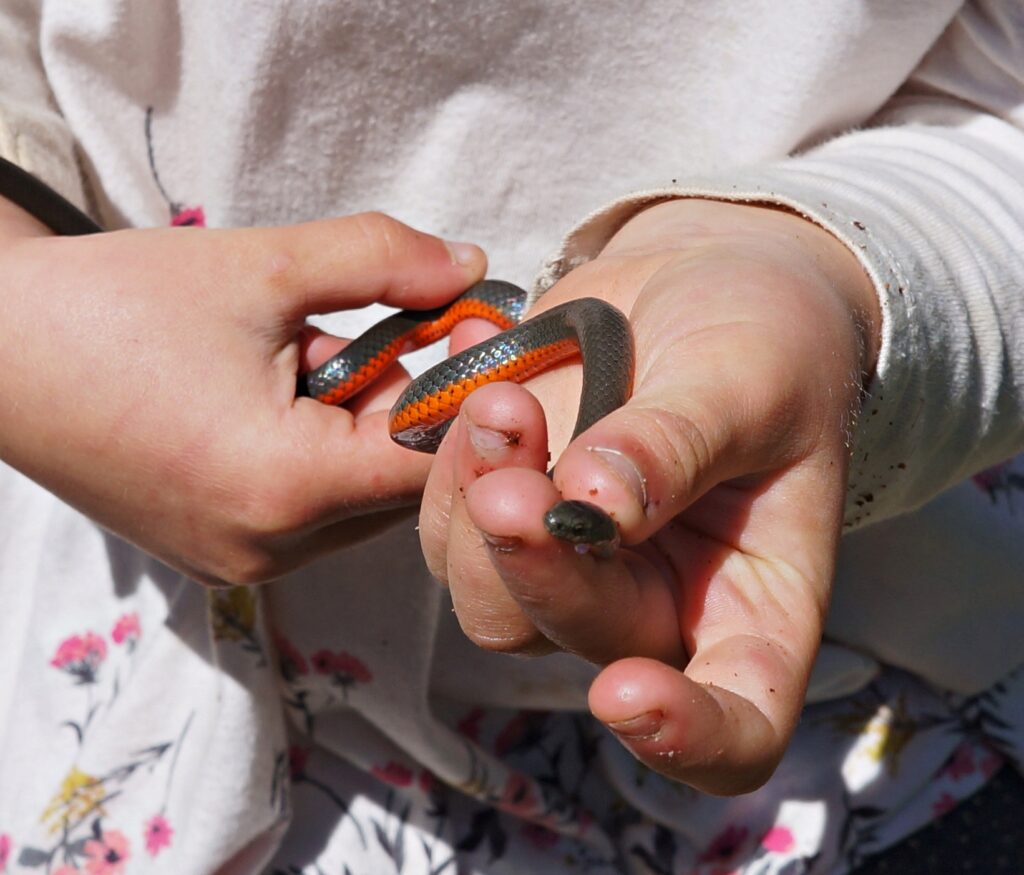 Diadophis punctatus amabilis
Diadophis punctatus amabilis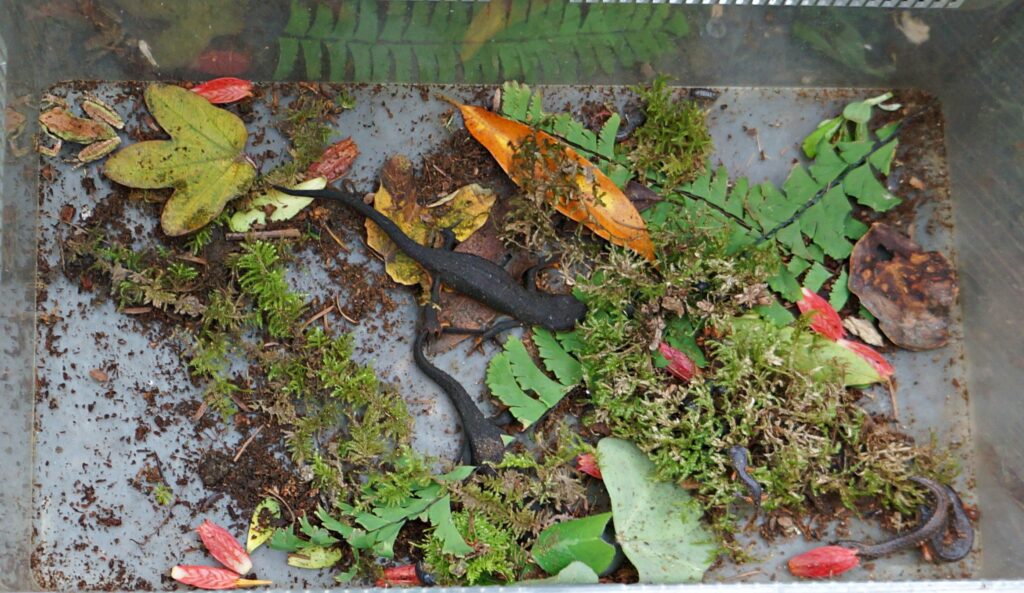 A child’s box of delights: rough-skinned newts, Ensatinas, slender salamanders and tree frog!
A child’s box of delights: rough-skinned newts, Ensatinas, slender salamanders and tree frog!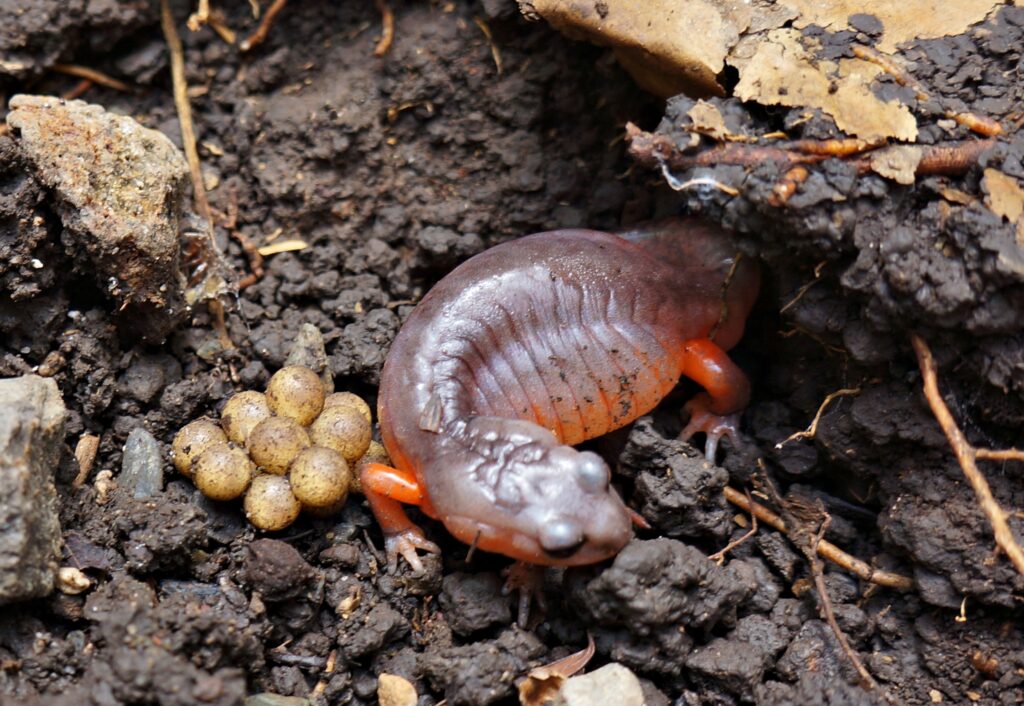 Ensatina with eggs
Ensatina with eggs
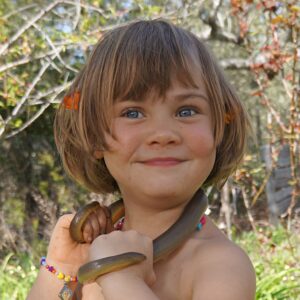
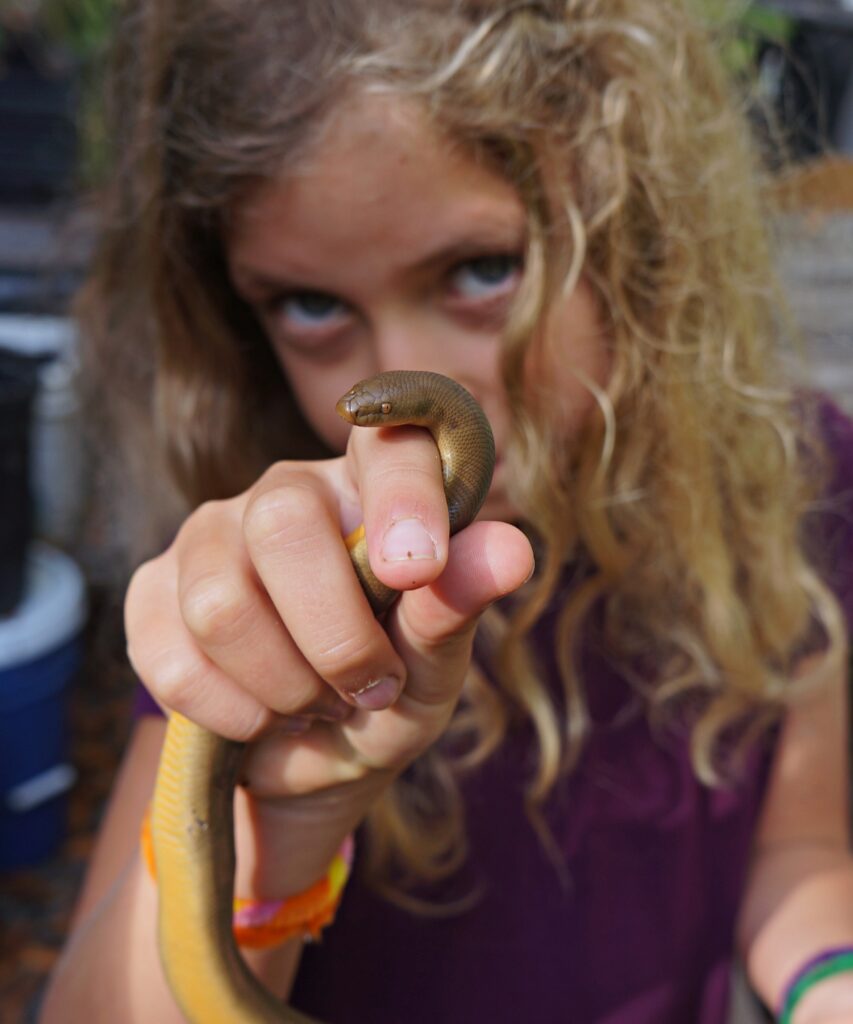 Kiera & Ember with Charina bottae
Kiera & Ember with Charina bottae
– ♠ –
–
LITTLE, BIG
Since 2020 I’ve been volunteering my help to a very special book project — an archival, art book edition of our friend John Crowley’s beloved novel Little, Big illustrated by Peter Milton, see our webpage. Winner of the World Fantasy Award when it was first published in 1981, the novel is esteemed by a broad diversity of fans — from Yale literary critic Harold Bloom to ethnobotanist Kat Harrison, from musician Maynard James Keenan to acclaimed storyteller Ursula K. LeGuin and psychedelic philosopher Terence McKenna. For many readers Little, Big is more than a novel, it is an an enchantment, an alchemical engine of the imagination. Publishing this unique new edition has been a 20 year saga, stalled by sundry issues. Recently I’ve had the pleasure of corresponding with celebrated fantasist Neil Gaiman, who has become a major supporter of the project, along with my friend and counterculture historian Erik Davis [see Erik’s new essay https://www.burningshore.com/p/big-little-big]. Their generosity has helped revivify the project and allowed printing to finally begin in 2022. The project’s architect and publisher, Ron Drummond, had a stroke June 2022 and since then book designer John D. Berry and myself have been tasked with overseeing the last stage of production and making sure all is in order to distribute books. Just updating the 18 years of customer records proved a considerable task; my volunteer work since summer 2022 has almost become a 2nd full time job. We are excited to report that the project is nearly complete; the hardcover edition is now shipping, but selling fast, plus a limited quantity of the signed, Numbered edition — invest in a copy while you can!
Books can be ordered through: https://store.deepvellum.org/products/little-big
~~~~~~
♦
NURSERY NEWS:
__
5/20/25 The First Plant Auction-Fundraiser of 2025 is now open for bidding! The Auction closes Monday, May 26 at 6pm PST.
Know that auction purchases will directly fund much needed nursery repairs to damage from the last several winters’ storms and increasing heat spikes throughout the year, essential renovations to our aging infrastructure, ongoing irrigation installation [after 20 years of hand-watering, we can no longer keep up and continue to lose plants due to a climatic shift towards hotter & drier], etc. Purchases also support our research and writing projects, as well as our continual conservation work—which includes propagating an untold number of rare and endangered plants that we’ve had waiting here for years, but have not had the time to multiply and distribute…
__
4/25/25 A new study in Nature Communication confirms a global increase in the frequency and severity of rapid temperature flips and the negative impacts this is having on agriculture, communities and ecosystems in general. We’ve increasingly experienced the hazards of this first hand, overnight spikes from cool to hot have been particularly damaging to many plants we grow, contributing to the devastating loss of about 1/4 of the species in our nursery and gardens over the last 8 years. Mitigating against extremes is no easy task, especially with the broad diversity of plants we grow, yet we continue to endeavor.
_
4/7/25 Spring has arrived after another winter of erratic and unpredictable weather. While some plants have tolerated the manic swings from unseasonal warm and dry, to deluge and cold, many others have suffered. This was yet another winter where many of our Trichocereus growing outside have sustained considerable damage. Not as extensive as the previous winter, but still far worse than we’re use to. This will continue to effect what cuttings we have to offer this year. Despite these, and a worrying number of other losses, we do have some new seedlings up to size which we’ll be offering in the coming months—first release Trichocereus hybrids, rare Bursera & Boswellia, Andean species, and unusual Edibles & Medicinals.
SPRING SALE! The largest sale we’ve had this year—significant discounts on over 3/4 of our Specimen Plants and our New and Rare & Used Books. This is also your last chance to order some of the Andean Tubers until next winter, with sales on several varieties.
All sale prices are good through April 30, or while supplies last. Many offerings are selling out, so order while you can!
_
Affirmation of the Imagination Podcast: Listen to a delightful conversation the folks at Weird Studies recently had with our friend Erik Davis about John Crowley’s novel Little, Big [we assisted the publication of the 40th anniversary edition]. Erik has previously written about this wondrous book, and here they use it as a springboard to talk about enchantment and the imagination, anomalous experiences, and the transporting power of prose. See – https://www.weirdstudies.com/187
__
2/20/25 January was the warmest and driest on record, forcing us to hand-water nearly all of our non-succulent container plants both within and outside the greenhouses—a first for this time of year! February has seen the rain return in full force with washed out roads and flooding not far from us…
_
Jonathan Ott Book Project:
[www.jonathanottbooks.com]
As previously mentioned, we are collaborating with Jonathan Ott on the publication of a deluxe series of twelve volumes, including five new titles and five new editions of his long-out-of-print books. These hand-made limited editions will be leather-bound, signed & numbered collector’s volumes with original art by renowned painter Donna Torres.
Production is underway, the launch to this exceptional series is a two-book box set of the long out-of-print Ayahuasca Analogues and Shamanic Snuffs—
the first 20 of these deluxe sets are now available to purchase! [6 remain unsold]
Ayahuasca Analogues and Shamanic Snuffs have been out of print for decades. The original editions of each individual title have recently sold online for more than the price of the entire, deluxe, new two-book set. Handmade with a level of artistic craftsmanship far beyond what you normally find in deluxe or limited edition books, this magnificent set is more than just a beautiful new edition of these engaging and historically important ethnobotanical monographs, but a work of art in itself! This gorgeous artifact is a worthwhile investment—made to last for generations, destined to become coveted by collectors and ever more valuable with time. Don’t pass up your chance to invest in this historical set now!
Ott Book Project Fundraiser—the very first of the Numbered Box Sets:
The first numbers in any limited edition are the most valuable, in this case these are not just the first numbered sets of AA/SS, but also the first in the entire twelve book series which we hope to publish in the coming years… with your support! To aid the Ott Book Project’s launch, and to help offset some initial obstacles, we’re offering the first ten of these collectible, signed & numbered box sets at fundraising prices. Currently, only one copy remains [#6]—order one while you can and help to fund this unique publishing project!
https://jonathanottbooks.com/product/limited_edition_ayahuasca_book/
 ↑ New, hand-bound, signed set of Ayahuasca Analogues and Shamanic Snuffs ↑
↑ New, hand-bound, signed set of Ayahuasca Analogues and Shamanic Snuffs ↑
__
Classes with Mateo Magee:
Our dear friend, and companion on many of our Andean expeditions, Mateo Magee, is offering an educational retreat in Wimberly, Texas, May 24–25, to share some of what he’s learned during the course of his unparalleled 27 years of apprenticeship in the healing systems of Andean curanderismo. See https://www.livingtheceremony.com/sacred-temple-gathering for more information and to reserve your place.
Mateo also has a number of amazing online classes and courses available: https://www.livingtheceremony.com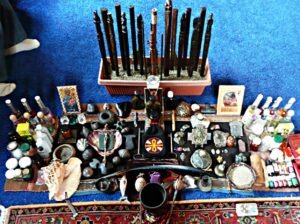
__
12/31/24 What a year… Despite many losses and challenges, we still firmly believe in the power of conservation through cultivation, that the garden & greenhouse are bio-banks for the future, and that plant diversity is essential to resilience during these times of adversity.
You have our deep appreciation for your support & compassion through the tumult of recent years. We still have significant renovation work to get the nursery back on track and return Sacred Succulents to full operation, but some notable progress has been made this year.
We have exciting new plants in the works and hope to return to offering more catalog species later in 2025.
It has been our humble pleasure to encourage deeper relations with plants for over 25 years now.
You have our sincere gratitude for your ongoing support of our endeavors.
As we all face the inevitable challenges of an increasingly erratic climate, may your plants & gardens provide some respite and many sublime moments of joy in the coming years!
__
12/29/24 We are currently working on a full descriptive and photographic account of our Trichocereus BK accessions distributed over the last two decades. The page is under construction and we hope to have it completed later in 2025, periodically check the page for updates.
__
12/18/24 The final Auction-Fundraiser of 2024 closed at 6pm PST, gratitude for everyone who participated — we greatly appreciate the support!
__
We have a limited number of Andean tubers available from now until the end of winter, or while supplies last. See our updated Andean Tuber Crops page.
2024 was another difficult year and we didn’t get to the tuber propagation we’d hoped, compounded by gophers chewing through the hardware-cloth at the bottom of several growing beds. We hope to build new raised-beds in 2025 and return to tuber production. Until then, our stock remains very limited. To honor ongoing requests, we also list [after the tubers] a small quantity of seed of other Andean Food Crops (kiwicha, kaniwa, quinoa, caigua, tarwi, etc.) to grow in your garden this coming season! This and the Specimen Seed is the only retail seed we are offering this year; international orders are welcome.
The Kew Royal Botanic Gardens has a nice article one some of the Andean tubers, see https://www.kew.org/read-and-watch/tuber-food-future
__
12/4/24 Books — We have a handful of historical artifacts for the serious collector:
We recently discovered an untouched case of the 1st edition softcover of Jonathan Ott’s seminal Pharmacotheon.
We also found we have a few more of the unsigned PiHKAL deluxe hardcover edition, see Rare & Used Editions ,
and a single TiHKAL deluxe hardcover signed by both Sasha and Ann Shulgin!
__
As some of you know, in addition to caring for thousands of plants, the last few years I’ve assisted in publishing the anniversary edition of my friend John Crowley’s 1981 award winning novel, Little, Big. The gorgeous hardcover edition is finally available, but with a limited print run it’s expected to sell out soon.
A wonderful gift and worthy investment — order a copy while you still can!
Solstice Sale! From now until 11:59pm 12/22/24, use the discount code “jcrowley” to receive 8% off your order of the Numbered edition, the Trade edition, or poster!
Don’t pass up your chance to invest in these gorgeous literary artifacts made to last for generations.
__
11/23/24 The weather in our region this autumn has been highly erratic; despite some early rain, many days were exceptionally warm, leading to plants losses in the gardens and nursery from the soil completely drying out —a first for us at this time of year. The frost arrived about 3 weeks later than usual, but instead of starting with a typical light freeze, it dropped straight to the mid 20s F, damaging plants that were still actively growing due to the unseasonal heat (luckily, just prior to this we’d moved much of the tender nursery stock ‘inside’). This week the rain arrived in full force, 20″+ of rain in just over 3 days has us rejoicing with the salamanders and frogs as the aquifers are refilling and the creeks have gone from dry to rushing full!
We are currently working on a full descriptive and photographic account of our Trichocereus BK accessions that we have distributed over the last two decades. We hope to have this posted on the website soon.
We are collaborating with our friend, the legendary ethnobotanist and author Jonathan Ott, on the publication of what is sure to become an historical phenomenon—a deluxe series of eleven volumes, including four new titles and three new editions of his long-out-of-print books. These hand-bound, signed & numbered collector’s volumes will each be limited to 300 slipcased, full leather-bound copies for sale. These are one-time Editions which will not be reprinted! We are elated to report that renowned ethnobotanical painter Donna Torres is producing original art for the full-color frontispieces. We’ll endeavor to release two titles a year as part of a collectible set in this exceptional series. Production is now underway, the first in the series will be a doubled edition of Ayahuasca Analogues and Shamanic Snuffs.
We hope to begin taking pre-orders in January, see www.jonathanottbooks.com
For now, if you are interested in receiving updates about the project, email benkamm@monitor.net with “Ott Books” as the subject.
__
10/30/24 Our heartfelt appreciation for everyone who took part in our fundraisers this month!
___
10/24/24 After it ended on 10/20, we heard from long term supporters that they never received the emails announcing the start & close of the Autumn fundraiser. We are still looking into why and a remedy. We had 1/8th the usual participants, the lowest number ever — many plants were bid on by only 2 people back & forth. Some of these individuals generously suggested a second fundraiser round on these plants — a make up auction for those who missed out.
We have decided to give this a go and list the relevant plants, each starting with the final high bid of the prior auction.
We’ve also posted a few alternate plants similar to those that went in the initial round.
To make the process more fair, we are implementing a trial “soft close” at the end of this auction.
This will allow a chance for participants to make a final bid offer on a popular plant even after the “close”.
While we don’t know if we’ll have our email list fixed by the close of this 2nd chance fundraiser on 10/30,
we hope this gives time for word to reach those who missed out — so tell your friends.
Everyone is welcome to take part in the make up auction! [Now closed]
___
10/21/24 The 2nd Plant Auction-Fundraiser of 2024 ended at 6pm PST, October 20. Our sincere thanks to those who took part.
NOTE: We heard from a number of long term customers that they never received the emails announcing the start and the close of the auction this week… We are at a loss as to why not everyone on the list received our posts and are looking into this. We noted that the number of folks taking part in the fundraiser was significantly lower than we’d ever seen, with about half the plants being bid on by only 2 people back & forth. We thought perhaps the timing was off, but it now seems at least partially due to issues with our email list.
We are considering how to best remedy this situation, especially for those who missed out.
Gratitude for your support!
___
10/15/24 It’s months later than we’d planned, but the second plant auction-fundraiser of 2024 is posted and we are now taking bids, see the new auction-fundraiser page.
There are fantastic, completely new releases, magnificent one-of-a-kind specimens, and awesome rarities that are not available anywhere else —
including plants we haven’t offered in many years, and likely won’t offer again for many more.
The auction closes Sunday, 10/20/24, at 6pm PST.
After the damage we’ve sustained the last 2 winters, and extreme heat spikes in summer taking a toll, these auctions are a big help in raising the support the nursery so vitally needs to continue — know that your auction purchases directly fund these much needed nursery repairs, essential renovations, ongoing irrigation installation [after 20 years of hand-watering, we can no longer keep up — we’ve lost over 25% of our rare & endangered plant collection in the last 5 years due to the climatic shift towards hotter & drier], equipment repair & replacement [for instance, the refrigerator we use exclusively for our seed bank died during the worst summer heat], as well as our continual research & conservation work.
We are deeply grateful for your love of plants and support of our work!
♠
Trichocereus Companions:
Recently, there has been a surge of interest in the horticultural merit of Trichocereus cacti, not just the famous “San Pedros” (T. pachanoi, T. bridgesii, T. peruvianus, T. santaensis, etc.), but many other species and the hundreds of hybrids we’ve produced in the last 3 decades. In what we have come to think of as ‘Trichomania’, the number of collectors has skyrocketed in the past decade from a couple hundred worldwide to many thousands! Species in this diverse Andean genus are often mistakenly thought of as sun-baked desert plants, yet many are in fact integral members of forest ecosystems—from Prosopis and Anadenanthera dry forests to Polylepis and Podocarpus cloudforests.
In habitat, Trichocereus occur with a diverse array of companion plants and we encourage you to try growing them with associated Andean species: in grouped plantings, in pots side by side, or even in the same pots—many associates are low growing or groundcovers that can be planted around the base of the columns. We currently have many such ally plants available (see the Succulent and the Andean sections of the Specimen Plant List): small succulents such as the aromatic, multifarious Peperomia spp., or Sedum, Ephedra, and Pilea species, to larger succulent companions like Agave cordillerensis, floriferous Puya & other terrestrial bromeliads (Abromeitiella, Deuterocohnia, etc.), or the caudiciform papaya Jacaratia; flowering bulbs—Cypella, Eustephia, Stenomesson; ferns like Blechnum; climbers such as Bomarea spp. & Ipomoea pubescens; low shrubs like the rare perennial tobacco Nicotiana benavidesii, Begonia boliviensis, the furry leafed Lessingianthus asteroflorus, Pernettya & other neotropical blueberries (Disterigma, Cavendishia, Macleania, etc.), fruiting Myrteola & Ugni; tall shrubs & trees like Colletia, Luma, Aristotelia, Sambucus, Podocarpus Polylepis, Escallonia, etc. Or use your imagination and choose plants from other regions of the world to fit a similar companion niche!
Trichocereus Companion Plant special offer —
The following 4 companion species for $52 [$66+ value] plus $16 shipping (while supplies last!): Agave cordillerensis, Eustephia sp.BK14512.9, Pilea serpyllacea, and Nicotiana benavidesii.
10/7/24 Just when we thought the cooler fall weather had arrived, the last 2 weeks have been brutal with oppressive heat. We’ve been scrambling to keep plants watered & alive and have been shocked to see a number of species damaged this past week that had tolerated hot, dry summers for decades…
___
9/28/24 Autumn is here and bountiful harvests of fruit and seed. All of the dry weather propagation we were not able to complete must now wait until next year. While the days are still warm and languorous, we know our first rains and frost are typically only a few weeks away. We are preparing the nursery for the seasonal change, returning plants to the safety of the greenhouse, encouraging succulents towards dormancy for their dry winter slumber. We’ll soon endeavor to sow a medley of things that we never got to last winter — various tree, shrub and bulb seeds that need the months of cold and wet to germinate in the spring…
Protecting our remnant US forests: I encourage you to check out Climate Forests https://www.climate-forests.org/ and sign their petition to let the US Forest Service know there’s support for protecting mature forests on federal lands — https://www.climate-forests.org/take-action
___
9/19/24 The last few weeks have finally seen a welcome mellowing of high temperatures here as the season turns towards autumn. The summer has been harsh, with periodic heat spikes that disrupted much of our propagation work. Very few plants appreciate the extremes and we’ve even seen species damaged that had otherwise weathered the vicissitudes of the past decade. Still, we’re adapting and have inched forward with nursery renovations.
_
I make an appearance in a lovely essay which Erik Davis just posted about Little, Big — my friend John Crowley’s 1981 award winning novel of which I’ve assisted in publishing the anniversary edition: https://www.burningshore.com/p/big-little-big
Stock is running low, books can be purchased through: https://store.deepvellum.org/products/little-big
A limited quantity of the signed, Numbered edition have just been made available!
Don’t pass up your chance to invest in these gorgeous literary artifacts made to last for generations.
___
7/9/24 A Tale of Life’s Resilience and Fragility:
In a reversal of the long held belief that the Malvaceous Baobab tree (Adansonia spp.) originated on mainland Africa and later dispersed to and diversified on Madagasar — a new study [ https://www.nature.com/articles/s41586-024-07447-4#Abs1 ] suggests Baobabs actually originated on Madagascar then dispersed (via their buoyant pods and the Indian Ocean gyre) to mainland Africa and north-west Australia (though a fully satisfactory story of the spread of Adansonia digitata across thousands of miles of Africa, nearly the entire continent, is lacking). All 6 of the wondrous Madagascar species of Baobab (threatened to highly endangered) are anachronisms that likely evolved with extinct giant lemurs as their prime dispersal agents — such as sloth lemurs (Archaeoindris & Palaeopropithecus spp.) and koala lemurs (Megaladapis spp.). [Up to gorilla-size, these huge lemurs began going extinct around 2000 years ago, shortly after humans settled on the island, though some species survived until at least 1000 years ago and possibly as recently as 500 years ago. See https://www.livescience.com/giant-koala-lemur-family-tree.html & https://www.nhm.ac.uk/discover/news/2020/june/only-known-drawing-of-extinct-giant-sloth-lemur-found-in-cave.html ]
A side note: Beat writer William S. Burroughs had a profound affection for lemurs; one our favorite Burroughs stories, Ghost of Chance, is about a Richard Evans Schultes-like explorer in Madagascar who eats some psychoptic plant and has visions of lemur evolution, including what could-have-been if certain family branches had not been hunted to their end…
___
7/1/24 The winter and spring were more tumultuous than I can convey — family illness, repeated storm damage, computer problems… on top of the calamities of 2023. Catalog updates and plant propagation continue to be delayed. We remain in a difficult position with most of our time taken up navigating obstacles, nursery repairs/renovations, and working to stabilize & salvage plants battered by the extremes of an increasingly manic climate. The good news is we are making some progress in the nursery this past month, we finally updated the Specimen Plant List, and things are on track for a fundraiser-auction later in July. It’s unlikely we’ll resume seed & PDF catalog orders anytime soon.
Gratitude for your patience and support these past 25+ years!
___
4/28/24 Family matters have continued to force my attention elsewhere the past month, but spring’s fecund verdure is calling me back to botanical endeavors…
Things are moving slowly, as I still face a lot of obstacles & uphill labor.
___
3/17/24 The past 6 weeks have been arduous. February was more chaotic than I can convey — a lost month.
Storms downed dozens of trees, causing repeated power outages (up to a week long), some flooding, closed roads, damage to the nursery, plant losses, etc.
The last few weeks have added family illness and a medley of computer issues. All this comes on top of the difficulties of 2023, plenty still unresolved…
Once again this puts us in a difficult position, unsure of the most viable route forward for SS…
I must beg your patience once more as we work to figure out what this means for our offerings this year.
___
12/8/23 It has been an unusual and erratic autumn — we’ve had early rains, early heavy frosts and late heat spells… all of which have continued to create new challenges in the nursery. After minimal trouble since last winter, this week a pair of our native Dusky-footed woodrats mowed a tray of Passiflora, half our Lapageria stock; they snipped a batch of Ilex vomitoria & Philesia seedlings and several rare Vaccinium, Gaultheria, and Pernettya. Sigh. We recovered some of the cut stems and will attempt to root, but this is another setback to future offerings.
The SPECIMEN PLANT LIST is updated for December, see partway down this page. The final and largest update of the year, we’ve added many new cacti & succulents, unique medicinals, Andean species (including a medley of rare Ericaceae) and our current stock of Andean Tubers. This is where we’ve listed a selection of the currently available retail plants. We’ve also posted the last of some Botanical Products — balsam resins, Goldroot, Muña oil, and a selection of New, Rare, and Used BOOKS near the bottom of this page. Several books are currently on sale, including Jonathan Ott’s essential titles. Some of the singular rarities we’ve listed come from the library of our late friend, the celebrated ethnobotanist Richard Felger.
___
10/30/23 We’re navigating the increasingly manic weather that seems to have become the norm — just over a week ago it was suddenly hot again, in the high 90s F, then 24 hours later it was raining and the temperature dropped nearly 40 degrees! Since then it has gotten colder; the last few mornings we were hit by rather significant frost — about 3 weeks earlier than we usually see this frozen. This damaged a bunch of leafy plants and has me scrambling to get the tender species moved into the greenhouses, the greenhouses damaged by last winter’s storms reskinned, and the nursery ready for what is predicted to be another wet winter.
___
10/6/23 This has proven to be a most calamitous year.
We lost most of the last 2 months and S.S. has been virtually ‘shut down’ during this time. Our eldest daughter brought COVID home from camp at the beginning of August; the girls recovered quickly, but I was hit pretty hard — it took me nearly 6 weeks to get my energy back and 8+ weeks on now I’m still experiencing some exasperating cognitive impairment. There was a period of extreme, flash heat while we were incapacitated with COVID — this caused a fair amount of damage within the nursery, even to some of the Trichocereus, which had barely recovered from winter injuries. The irrigation system recently installed in some sections of the nursery prevented all out catastrophe. We can say, unequivocally, that we’ve lost more plants in 2023 than any other year in Sacred Succulents 25 year history. We’ve also accomplished less propagation this summer than any I recall. We’re uncertain to what extent this will impact our offerings in future seasons, but right now it means our retail lists are in need of significant revision — a task which I’m unlikely to accomplish until this winter. In the interim, we’re not handling seed orders until sometime in 2024 and availability should be confirmed via email for all retail plant orders.
___
7/27/23 Months later and we are still seeing new evidence of damage from last winter’s extreme weather. Until recently, this had been the foggiest and coolest summer we’ve had in over a decade. This has made recovery and cleaning up the winter damaged Trichocereus problematic and new growth slower than any year I can recall! We’ve also been peppered with sporadic sudden heat spikes—these extreme temperature swings have been hard on many plants. We’re discovering more plants failing to wake from dormancy and damage among some of the species in the greenhouses, greater than anything we’ve seen before. In the last several months we’ve lost about 70% of our Andean Echeveria, over a dozen of our large Burseraceae mother plants (Copal, Frankincense, Myrrh), and a fair number of globular cacti — Ariocarpus, Turbinicarpus, Mammillaria, etc. This is humbling and perplexing, to say the least. I can’t piece together all of the causes of the damage and loss… some of it makes no sense I can track; it seems to be a complex accumulation of factors. Propagation this year has primarily been limited to our efforts to salvage damaged plants, and looks to remain so for the season. All this will have a notable impact on our future offerings. Under these current circumstance, new orders should be restricted to items on the Specimen Plant List [halfway down this page]—we have to discourage new orders from our retail PDF lists until we can entirely update them; you’re welcome to make inquiries, just know that there’s a fair number of plants/seeds that won’t be available until next year…if again at all. Once more, I apologize for the inconvenience.
Not all is woe, we continue to at least inch forward with essential nursery renovations. Some of the plants we’ve lost we have backed up at various botanical gardens, and, of course, in the gardens of some of you fine phytophiles. Many of our Asian and Andean shrubs and trees have thrived in the cooler weather, plus we finally seem to have entered a stretch of sunny summer days. We have managed to plant some seed, including fresh batches of Boswellia and Bursera; we also have seedlings of exciting new Trichocereus hybrids coming along which we hope to offer this winter or next season.
___
3/29/23 This winter has been hard on the nursery & gardens. Since the new year, we’ve been repeatedly battered by large storms — high winds, torrential rain, sleet & hail, even freak snow, along with numerous power outages lasting from 1 to 5 days. The storms damaged several nursery structures, the deluge repeatedly washed out segments of our driveway and parts of the nursery. For a couple days in mid-March, half of our lower garden and the adjacent portion of the nursery had a few inches of water flowing through. In-between the storms we’ve had unseasonal warm & sunny days, with a temperatures in the 60s & 70s (° F), and frequent freezing nights as cold as 18° F. Such capricious weather has caused a great deal of damage to our plants — the high humidity in the greenhouses resulted in mold & rot issues with some succulents, while we lost assorted leafy plants due to the drying heat of unseasonable sun unexpectedly warming the greenhouses to over 80° F! Outside, the Trichocereus cacti have taken an irregular amount of damage from the erratic climatic extremes. Inexplicably, species which have historically been the hardiest for us (T. terscheckii, pasacana, & the clumping species and hybrids) have been among the hardest hit. Injuries are still showing up on plants and we likely won’t know the full extent of the damage until late spring. In addition to all this, it has been the worst cold & flu season we have ever experienced — since autumn, my daughters have brought some malady home from school to share with the family at least once or twice a month.
The absurd vicissitudes these past months have frustrated my attempts to update the website & catalog and have severely interrupted my usual winter propagation work, seed cleaning and sowing. Efforts to finally complete the nursery renovations have also been greatly effected — in fact the storms have necessitated additional renovations. With the heroic help of my colleague, Matt Magee, we were able to accomplish some work: constructing a 25′ shade structure to replace one blown down in January, removing 30′ of decrepit wooden benches and rebuilding a metal bench in their place, complete with 8′ propagation chamber on one end.
All of these intractable events have had a real impact on our plans for the year and the availability of many plants. We had planned to fully resume retail operations this spring… but alas, circumstances demand that we once again limit retail plant & seed sales and shipping.
___
1/9/23 A large storm came through and we lost power, internet and phone last Wednesday, January 4, and only just got these back last night. There’s been flooding and an inordinate number of fallen trees throughout the county. An old 8′ by 25′ long redwood and shadecloth structure broke in the high winds and was blown against one of our smaller greenhouses–damaging the skin but not the frame of that structure. This apparently excited a pair of amorous woodrats who were moved by the destruction to focus their passions on snipping several trays of plants — our stock of Desfontainia, Amomyrtus, and Ilex vomitoria are nearly decimated, along with some rare Vaccinium and Gaultheria. The rain deluge eroded part of our driveway and some areas around the nursery, but no flooding — in fact the positive side of all this is that our creek is finally back to a healthy level and the aquifers are being replenished, for which we are deeply grateful. The dismal anthropogenic interaction with the northern California ecosystems here the last 160+ years means that many of our watersheds and forests are a disaster with these heavy rains–especially after the drought and fires the last few years.
___
11/23/22 We just discovered that our friend Ken Symington passed away in September at the age of 90. Ken was a Cuban born chemical engineer and one of the unsung heroes of the entheobotany renaissance of the 1990s. With Rob Montgomery, Terence McKenna, and Jonathan Ott, Ken organized progressive educational conferences around the world including the famous annual gatherings in Palenque, Chiapas, Mexico — where we first met many fine folks in 1994. We all have Ken to thank for the beautiful English translation of one of the most poetic books on Amazonian mythology, plant lore and wizardry: Cesar Calvo’s classic The Three Halves of Ino Moxo. Ken was a kind and radiant soul who encouraged us to follow a green and flower strewn life path. We were blessed to have known him.
___
10/12/22 We are mourning our colleague Christian Rätsch, who died last month. Christian was pioneer scholar of psychoactive ethnobotany and the reclamation of Euro-pagan traditions and plant preparations. His research, joyous curiosity and beautiful books have inspired us for the last three decades. Christian was a monument to himself — an utterly unique man that greatly enriched the lives of many folks through sharing his love and fascination with the remote and forgotten facets of our world. Some of his 40+ books have been translated from his native German to English, such as The Encyclopedia of Psychoactive Plants, The Encyclopedia of Aphrodisiacs, Shamanism and Tantra in the Himalayas, Witchcraft Medicine, Pagan Christmas, etc. Photographs of plants we grew grace the pages of several of these titles. May we all strive to leave the world a richer, better place as Christian has.
You can read about a few of our memories of Christian.
___
3/24/22 Many nurseries operate seasonally and it now makes sense for us to adopt something similar. As mostly a one man show it is simply no longer viable for us to maintain shipping 5 days week year round as we have for the past 24+ years. We are currently limiting the extent and frequency of shipping orders.
After years of perpetually diversifying and expanding our catalog offerings we have come to a point where we have to consider some downsizing to return Sacred Succulents to a more manageable state of operation for us. To this end and to safeguard our decades of conservation work we have in recent years donated or distributed hundreds of rare and endangered plants to the UC Berkeley Botanical Gardens, the California Academy of Sciences, the Huntington Botanical Gardens, the Ventura Botanical Gardens, the Seattle Spheres, the UC Fullerton Greenhouses— to name a few organizations we have received very positive recognition from for our work & contributions. Thus, there are some of our catalog listings that will not be available again after this year.
We are enacting and exploring these and other changes to protect the long term viability of Sacred Succulents. This means that we will only be shipping retail orders intermittently as we continue to take time out to complete essential renovations, reconfigure aspects of our operation (to protect the long term viability of Sacred Succulents in light of our erratically changing climate), and ultimately return to the level of customer service that we have historically offered.
___
10/27/21 We got word that our friend Gabriel Howearth was swept away in a flood last August. Gabriel was a lauded conservationist and co-founder of Seeds of Change. He’s been an inspiration and unwavering champion of our own work for the past two decades.
One of the great seedsman of our age, gone…
You can read more about him: https://bioneers.org/a-tribute-to-gabriel-howearth-champion-of-biodiversity-zmbz2109/
___
11/26/20 Sacred Succulents has always been a small family run business, for all practical purposes most of it has really been a one man show. Yet it is also a complex ever growing entity. For over 23 years now a few thousand of you fine folks around the world have contributed to our existence and ongoing endeavors. There are no words we know that can fully express our deep and sincere gratitude for your support and enthusiasm over the years. We would not exist without you. Collectively we have introduced hundreds of new plants into cultivation, hopefully safeguarding some from extinction and cultural loss. And of course at the heart of our gratitude is the plants themselves – we are all truly blessed to be born of such a fecund world with an astounding diversity of vegetal wonders to nourish and flourish us.
___
11/3/20 Our friend Richard Felger died on October 31. He was a giant in the world of ethnobotany and conservation, a poet and man of great heart. He left the world greatly enriched by his work and books, yet we can’t help feel the world is still a bit poorer without his presence… For more on Richard’s amazing work see – https://www.desertfoodplants.org/
___
8/15/20 We are all feeling the strain of the pandemic as we watch the tide of human desire and will break upon the rocky shore of bio-physical reality. As we recalibrate aspects of the nursery and shipping schedules we hope to give our self more time for writing and research. We just added a few pieces to the Botanical Reflections page of the website; the first time we’ve updated this page in 9 years. Here you can find a smattering of our writing; childhood botanical musings, our floral assessment of a remote Incan site, bizarre genealogy, and pondering the fictions of taxonomy. We will post more eventually.
___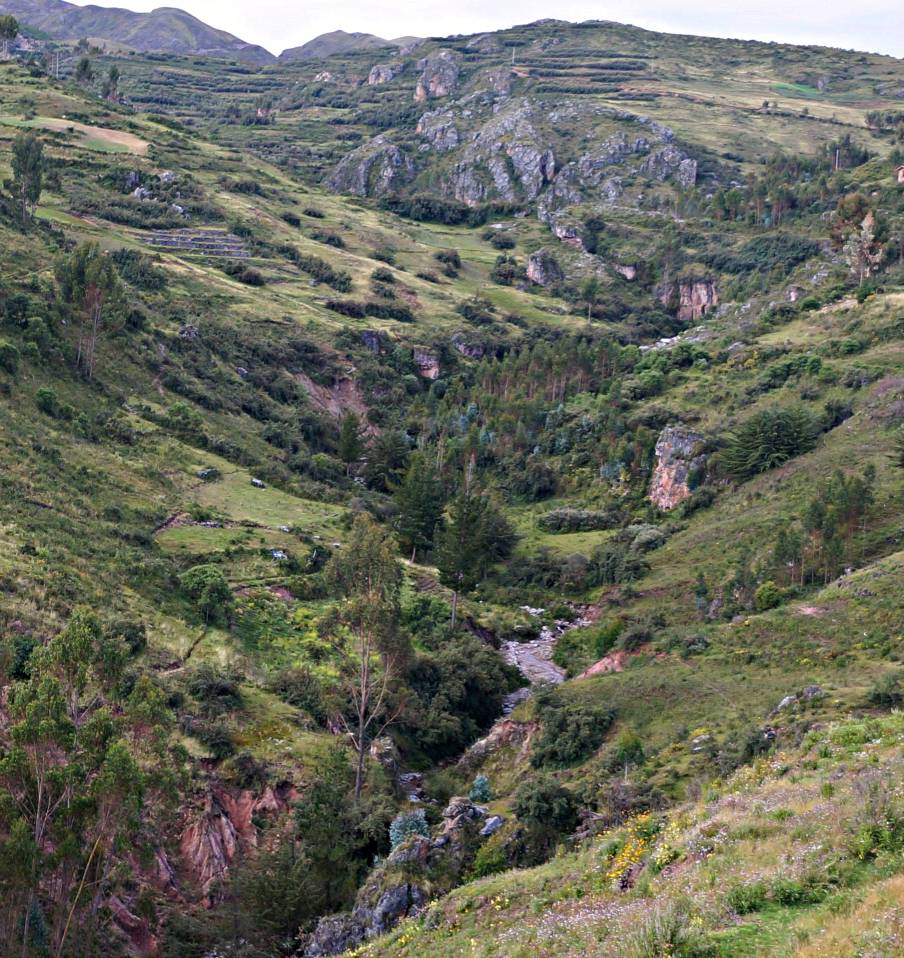 The site of the Incan shrine and remnant Polylepis forest of Chakan, above Cusco, Peru
The site of the Incan shrine and remnant Polylepis forest of Chakan, above Cusco, Peru
© Unless noted otherwise, all sacredsucculents.com web text and images copyright Ben Kamm ©
